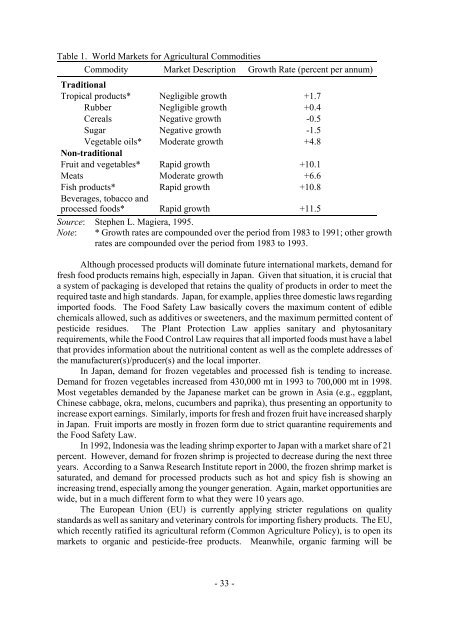Development of Agribusiness Enterprises - Asian Productivity ...
Development of Agribusiness Enterprises - Asian Productivity ...
Development of Agribusiness Enterprises - Asian Productivity ...
Create successful ePaper yourself
Turn your PDF publications into a flip-book with our unique Google optimized e-Paper software.
Table 1. World Markets for Agricultural Commodities<br />
Commodity<br />
Traditional<br />
Market Description Growth Rate (percent per annum)<br />
Tropical products* Negligible growth +1.7<br />
Rubber Negligible growth +0.4<br />
Cereals Negative growth -0.5<br />
Sugar Negative growth -1.5<br />
Vegetable oils*<br />
Non-traditional<br />
Moderate growth +4.8<br />
Fruit and vegetables* Rapid growth +10.1<br />
Meats Moderate growth +6.6<br />
Fish products*<br />
Beverages, tobacco and<br />
Rapid growth +10.8<br />
processed foods* Rapid growth +11.5<br />
Source: Stephen L. Magiera, 1995.<br />
Note: * Growth rates are compounded over the period from 1983 to 1991; other growth<br />
rates are compounded over the period from 1983 to 1993.<br />
Although processed products will dominate future international markets, demand for<br />
fresh food products remains high, especially in Japan. Given that situation, it is crucial that<br />
a system <strong>of</strong> packaging is developed that retains the quality <strong>of</strong> products in order to meet the<br />
required taste and high standards. Japan, for example, applies three domestic laws regarding<br />
imported foods. The Food Safety Law basically covers the maximum content <strong>of</strong> edible<br />
chemicals allowed, such as additives or sweeteners, and the maximum permitted content <strong>of</strong><br />
pesticide residues. The Plant Protection Law applies sanitary and phytosanitary<br />
requirements, while the Food Control Law requires that all imported foods must have a label<br />
that provides information about the nutritional content as well as the complete addresses <strong>of</strong><br />
the manufacturer(s)/producer(s) and the local importer.<br />
In Japan, demand for frozen vegetables and processed fish is tending to increase.<br />
Demand for frozen vegetables increased from 430,000 mt in 1993 to 700,000 mt in 1998.<br />
Most vegetables demanded by the Japanese market can be grown in Asia (e.g., eggplant,<br />
Chinese cabbage, okra, melons, cucumbers and paprika), thus presenting an opportunity to<br />
increase export earnings. Similarly, imports for fresh and frozen fruit have increased sharply<br />
in Japan. Fruit imports are mostly in frozen form due to strict quarantine requirements and<br />
the Food Safety Law.<br />
In 1992, Indonesia was the leading shrimp exporter to Japan with a market share <strong>of</strong> 21<br />
percent. However, demand for frozen shrimp is projected to decrease during the next three<br />
years. According to a Sanwa Research Institute report in 2000, the frozen shrimp market is<br />
saturated, and demand for processed products such as hot and spicy fish is showing an<br />
increasing trend, especially among the younger generation. Again, market opportunities are<br />
wide, but in a much different form to what they were 10 years ago.<br />
The European Union (EU) is currently applying stricter regulations on quality<br />
standards as well as sanitary and veterinary controls for importing fishery products. The EU,<br />
which recently ratified its agricultural reform (Common Agriculture Policy), is to open its<br />
markets to organic and pesticide-free products. Meanwhile, organic farming will be<br />
- 33 -
















